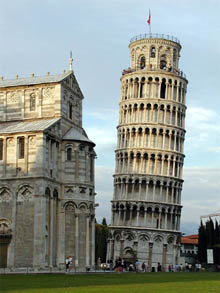
The tower in Pisa is leaning, but it is not falling; it is expected to last another 300 years
 |
During the last century, the leaning of the tower increased to about four and a half meters, so it had to be closed in 1990. This was followed by a very complex and expensive operation (costing over 28 million euros) that managed to halt the leaning and even "straighten" the monument to the state it was in 300 years ago. The top of the bell tower is now about four meters off the vertical axis. There is no interest in completely straightening the campanile, as tourists would lose a unique experience.
The tower in mid-Italy's Pisa was built in the Square of Miracles in several stages between 1174 and 1372. The cylindrical structure began to lean due to the unstable foundation even after the first three floors were completed (interestingly, in the opposite direction) and the builders tried to optically balance it by inserting trapezoidal stones. However, they never completely stopped the leaning. The height of the bell tower is 56 meters, with experts estimating its weight at 14,000 tons. The tower houses seven bells.
Until the completion of reconstruction work in 2001, experts managed to reduce the monument's tilt by about 44 centimeters with the help of several thousand tons of counterweights in the foundation and securing it with strong steel cables. The reduction in the slope of the late Romanesque tower is not discernible to the naked eye, but it is sufficient for its stabilization. Subsequent monitoring has also shown that the bell tower is no longer leaning from its axis. According to structural engineers, it is safe for another 300 years.
Over 9,000 projects have been created to save the tower, which allegedly remembers Galileo Galilei's experiments with gravity. Not all solutions were successful. Both scientists and charlatans from around the world tried to straighten the bell tower. One idea was to build a second tower that would lean in the opposite direction and support the old campanile. One citizen of Pisa even proposed that the tower be supported by an outstretched arm on a huge statue of Saint Ranieri, the city's patron.
The authors of the building, which serves as the bell tower of the neighboring basilica (the complex also includes a baptistery and a cemetery), are considered to be Bonnano Pisano and Tommaso Pisano. Italian researcher Antonino Caleca, however, concluded that the design is likely the work of architect Gerardo di Gerardo and the renowned sculptor Giovanni Pisano. The fact that the campanile still stands can also be attributed to the ingenious adaptability of the builders of the last levels of the tower to the laws of gravity.
The Leaning Tower of Pisa is not a solitary rarity in the world. Leaning structures can also be found in Bologna, Italy (12th century), in Bautzen, Saxony (late 15th century), or in Toruń, Poland.
The English translation is powered by AI tool. Switch to Czech to view the original text source.
0 comments
add comment












